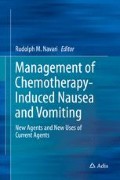Abstract
Chemotherapy-induced nausea and vomiting (CINV) is associated with a significant deterioration in quality of life and is perceived by patients as a major adverse effect of the treatment [1, 2]. Increased risk of CINV is associated with the type of chemotherapy administered (Table 1.1) and specific patient characteristics (Table 1.2) [3]. CINV can result in serious complications, such as weakness, weight loss, electrolyte imbalance, dehydration, or anorexia, and is associated with a variety of complications, including fractures, esophageal tears, decline in behavioral and mental status, and wound dehiscence [1]. Patients who are dehydrated, debilitated, or malnourished, as well as those who have an electrolyte imbalance or those who have recently undergone surgery or radiation therapy, are at greater risk of experiencing serious complications from CINV [1–3].
Access this chapter
Tax calculation will be finalised at checkout
Purchases are for personal use only
References
Bloechl-Daum B, Deuson RR, Mavros P et al (2006) Delayed nausea and vomiting continue to reduce patients’ quality of life after highly and moderately emetogenic chemotherapy despite antiemetic treatment. J Clin Oncol 24:4472–4478
Cohen L, de Moor CA, Eisenberg P et al (2007) Chemotherapy-induced nausea and vomiting: incidence and impact on patient quality of life at community oncology settings. Support Care Cancer 15(5):497–503
Navari RM (2009) Pharmacological management of chemotherapy-induced nausea and vomiting: focus on recent developments. Drugs 69:515–533
Navari RM (2010) Palonosetron for the prevention of chemotherapy-induced nausea and vomiting in patients with cancer. Future Oncol 6:1074–1084
Curran MP, Robinson DM (2009) Aprepitant: a review of its use in the prevention of nausea and vomiting. Drugs 69:1853–1858
Sankhala KK, Pandya DM, Sarantopoulos J et al (2009) Prevention of chemotherapy induced nausea and vomiting: a focus on aprepitant. Expert Opin Drug Metab Toxicol 12:1607–1614
Navari RM (2015) Profile of netupitant/palonosetron fixed dose combination (NEPA) and its potential in the treatment of chemotherapy-induced nausea and vomiting (CINV). Drug Des Dev Ther 9:155–161
Navari RM (2015) Rolapitant for the treatment of chemotherapy induced nausea and vomiting. Expert Rev Anticancer Ther 15:1127–1133
Navari RM, Einhorn LH, Loehrer PJ et al (2007) A phase II trial of olanzapine, dexamethasone, and palonosetron for the prevention of chemotherapy-induced nausea and vomiting. Support Care Cancer 15:1285–1291
Tan L, Liu J, Liu X et al (2009) Clinical research of olanzapine for the prevention of chemotherapy-induced nausea and vomiting. J Exp Clin Cancer Res 28:1–7
Navari RM, Gray SE, Kerr AC (2011) Olanzapine versus aprepitant for the prevention of chemotherapy-induced nausea and vomiting: a randomized phase III trial. J Support Oncol 9:188–195
Navari RM (2012) Treatment of chemotherapy-induced nausea. Community Oncol 9:20–26
Stern RM, Koch KL, Andrews PLR (eds) (2011) Nausea: mechanisms and management. Oxford University Press, New York
Roila F, Herrstedt J, Aapro M et al (2010) Guideline update for MASCC and ESMO in the prevention of chemotherapy- and radiotherapy-induced nausea and vomiting: results of the Perugia consensus conference. Ann Oncol 21(5):232–243
Basch E, Prestrud AA, Hesketh PJ et al (2011) Antiemetic American Society Clinical Oncology clinical practice guideline update. J Clin Oncol 29:4189–4198
NCCN Clinical Practice Guidelines in Oncology version 1 2015. Antiemesis. National Comprehensive Cancer Network (NCCN) [online]. Available from URL: http://www.nccn.org/professionals/physician_gls/PDF/antiemesis.pdf. Accessed Oct 2015
Author information
Authors and Affiliations
Corresponding author
Editor information
Editors and Affiliations
Rights and permissions
Copyright information
© 2016 Springer International Publishing Switzerland
About this chapter
Cite this chapter
Navari, R.M. (2016). Introduction. In: Navari, R. (eds) Management of Chemotherapy-Induced Nausea and Vomiting. Adis, Cham. https://doi.org/10.1007/978-3-319-27016-6_1
Download citation
DOI: https://doi.org/10.1007/978-3-319-27016-6_1
Published:
Publisher Name: Adis, Cham
Print ISBN: 978-3-319-27014-2
Online ISBN: 978-3-319-27016-6
eBook Packages: MedicineMedicine (R0)

